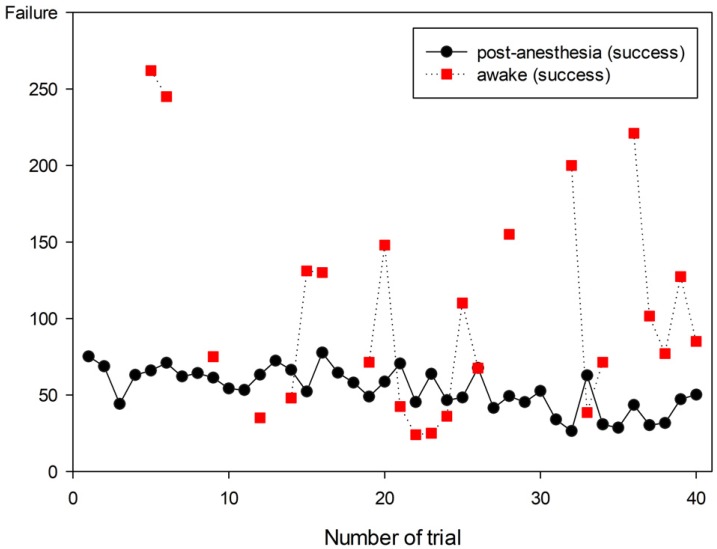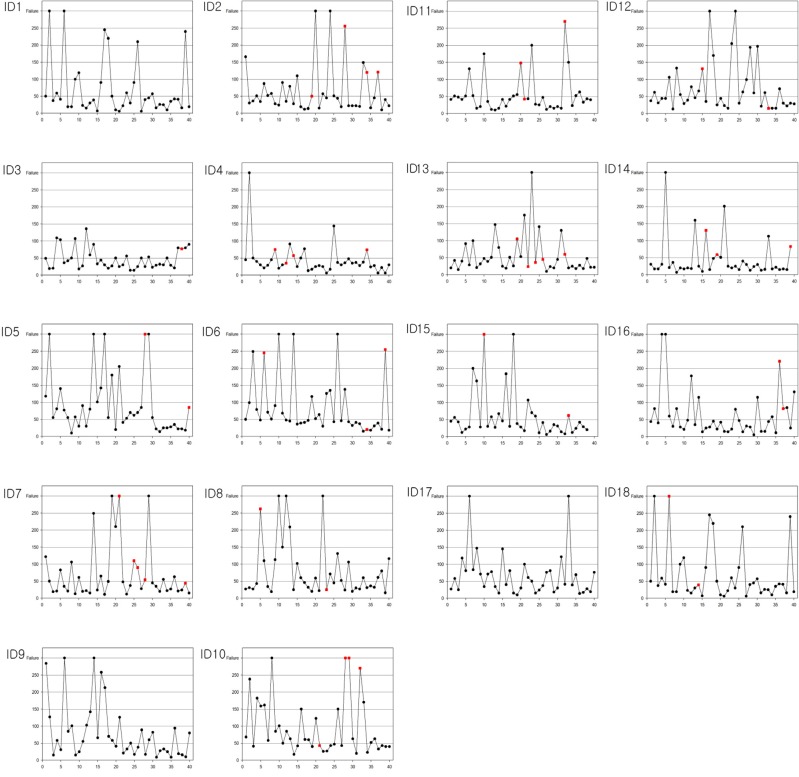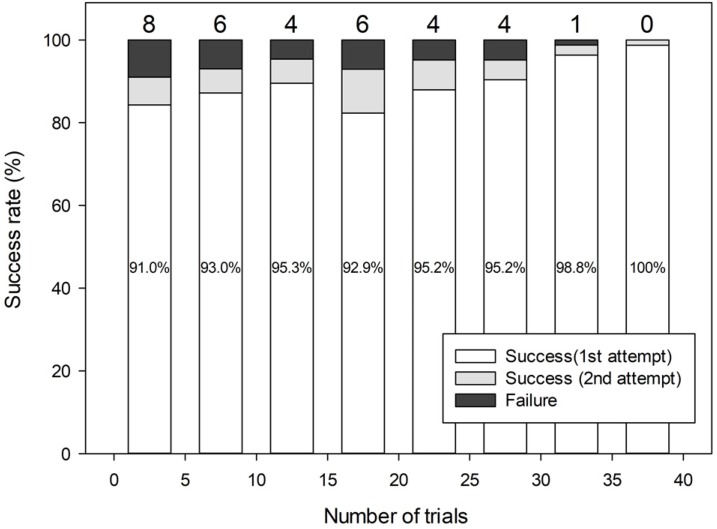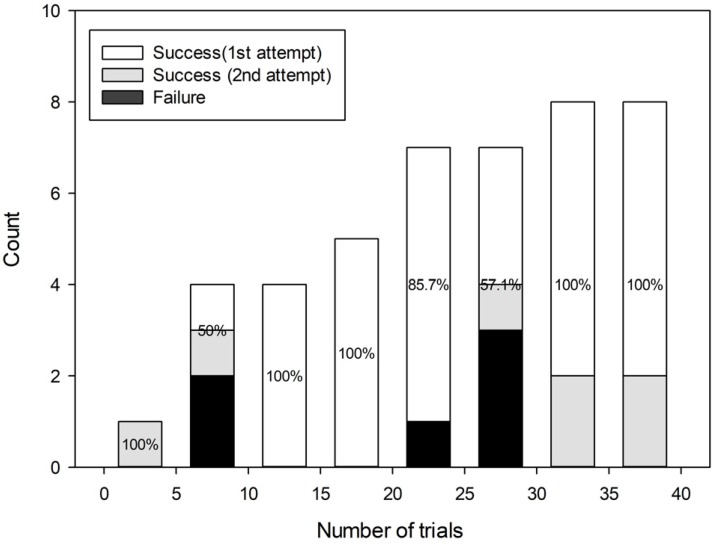1. Mahmood S, Lowe T. Management of epistaxis in the oral and maxillofacial surgery setting: An update on current practice. Oral Surg Oral Med Oral Pathol Oral Radiol Endod. 2003; 95:23–29. PMID:
12539023.

2. Apfelbaum JL, Hagberg CA, Caplan RA, Blitt CD, Connis RT, Nickinovich DG, et al. Practice guidelines for management of the difficult airway: An updated report by the american society of anesthesiologists task force on management of the difficult airway. Anesthesiology. 2013; 118:251–270. PMID:
23364566.
3. Delaney KA, Hessler R. Emergency flexible fiberoptic nasotracheal intubation: A report of 60 cases. Ann Emerg Med. 1988; 17:919–926. PMID:
3415064.

4. Ovassapian A, Yelich SJ, Dykes MH, Brunner EE. Fiberoptic nasotracheal intubation--incidence and causes of failure. Anesth Analg. 1983; 62:692–695. PMID:
6859572.

5. Smith JE, Jackson AP, Hurdley J, Clifton PJ. Learning curves for fibreoptic nasotracheal intubation when using the endoscopic video camera. Anaesthesia. 1997; 52:101–106. PMID:
9059089.

6. Ovassapian A, Yelich SJ, Dykes MH, Golman ME. Learning fibreoptic intubation: Use of simulators v. Traditional teaching. Br J Anaesth. 1988; 61:217–220. PMID:
3415894.
7. Dalal PG, Dalal GB, Pott L, Bezinover D, Prozesky J, Bosseau Murray W. Learning curves of novice anesthesiology residents performing simulated fibreoptic upper airway endoscopy. Can J Anaesth. 2011; 58:802–809. PMID:
21710368.

8. Johnson C, Roberts JT. Clinical competence in the performance of fiberoptic laryngoscopy and endotracheal intubation: A study of resident instruction. J Clin Anesth. 1989; 1:344–349. PMID:
2627408.
9. Caplan RA, Posner KL, Ward RJ, Cheney FW. Adverse respiratory events in anesthesia: A closed claims analysis. Anesthesiology. 1990; 72:828–833. PMID:
2339799.

10. Bailie R, Posner KL. New trends in adverse respiratory events. ASA Newsl. 2011; 75:28–29.
11. Huitink JM, Lie PP, Heideman I, Jansma P, Greif R, Schagen Nv, et al. A prospective, cohort evaluation of major and minor airway management complications during routine anaesthetic care at an academic medical centre. Anaesthesia. 2017; 72:42–48. PMID:
27665740.

12. Buis ML, Maissan IM, Hoeks SE, Klimek M, Stolker RJ. Defining the learning curve for endotracheal intubation using direct laryngoscopy: A systematic review. Resuscitation. 2016; 99:63–71. PMID:
26711127.

13. Ovassapian A. Fiberoptic tracheal intubation. Fiberoptic Airway Endoscopy in Anesthesia and Critical Care. New York: Raven Press;1990. p. 57–79.
14. Korttila K, Tarkkanen J, Tarkkanen L. Comparison of laryngotracheal and ultrasonic nebulizer administration of lidocaine in local anaesthesia for bronchoscopy. Acta Anaesthesiol Scand. 1981; 25:161–165. PMID:
7324824.

15. Somerson SJ, Sicilia MR. AANA journal course: update for nurse anesthetists--beyond the laryngoscope: advanced techniques for difficult airway management. AANA J. 1993; 61:64–71. PMID:
8368059.
16. Machata AM, Gonano C, Holzer A, Andel D, Spiss CK, Zimpfer M, et al. Awake nasotracheal fiberoptic intubation: Patient comfort, intubating conditions, and hemodynamic stability during conscious sedation with remifentanil. Anesth Analg. 2003; 97:904–908. PMID:
12933427.

17. Cormack RS, Lehane J. Difficult tracheal intubation in obstetrics. Anaesthesia. 1984; 39:1105–1111. PMID:
6507827.

18. Collins SR, Blank RS. Fiberoptic intubation: An overview and update. Respir Care. 2014; 59:865–878. PMID:
24891196.

19. K Nasa V, Kamath SS. Risk factors assessment of the difficult intubation using intubation difficulty scale (IDS). J Clin Diagn Res. 2014; 8:GC01–GC03.
20. Kim HW, Seo KS, Shin TJ, Kim HJ. The effect of laryngeal view grade and intraoral bleeding on intubation difficulty during fiberoptic nasotracheal intubation. J Korean Dent Soc Anesthesiol. 2009; 9:91–97.

21. Sanuki T, Hirokane M, Kotani J. Epistaxis during intubation: A comparison of nostril sides. J Oral Maxillofac Surg. 2010; 68:618–621. PMID:
19931965.
22. Lai HC, Chang YH, Huang RC, Hung NK, Lu CH, Chen JH, et al. Efficacy of sevoflurane as an adjuvant to propofol-based total intravenous anesthesia for attenuating secretions in ocular surgery. Medicine. 2017; 96:e6729. PMID:
28445291.

23. O'Connell JE, Stevenson DS, Stokes MA. Pathological changes associated with short-term nasal intubation. Anaesthesia. 1996; 51:347–350. PMID:
8686823.
24. Morimoto Y, Sugimura M, Hirose Y, Taki K, Niwa H. Nasotracheal intubation under curve-tipped suction catheter guidance reduces epistaxis. Can J Anaesth. 2006; 53:295–298. PMID:
16527796.

25. Elwood T, Stillions DM, Woo DW, Bradford HM, Ramamoorthy C. Nasotracheal intubation: A randomized trial of two methods. Anesthesiology. 2002; 96:51–53. PMID:
11753001.
26. Kameyama K, Watanabe S, Kano T, Kusukawa J. Effects of nasal application of an epinephrine and lidocaine mixture on the hemodynamics and nasal mucosa in oral and maxillofacial surgery. J Oral Maxillofac Surg. 2008; 66:2226–2232. PMID:
18940484.

27. Kwon MA, Song J, Kim S, Ji SM, Bae J. Inspection of the nasopharynx prior to fiberoptic-guided nasotracheal intubation reduces the risk epistaxis. J Clin Anesth. 2016; 32:7–11. PMID:
27290935.









 PDF
PDF ePub
ePub Citation
Citation Print
Print








 XML Download
XML Download